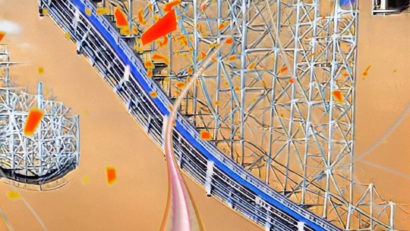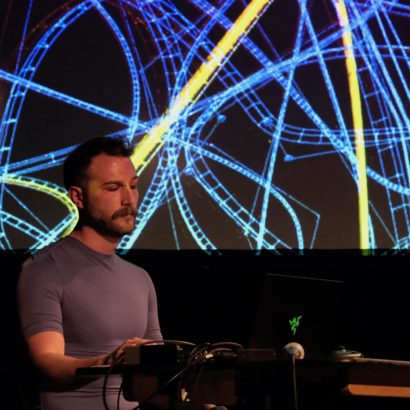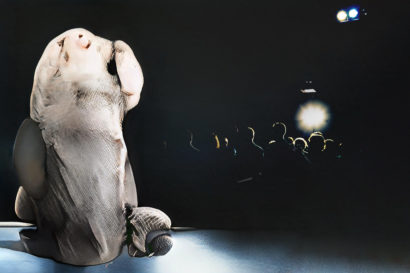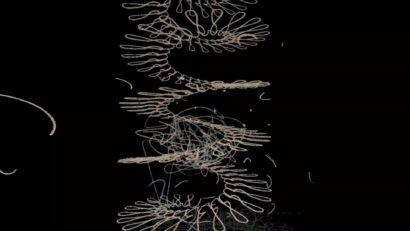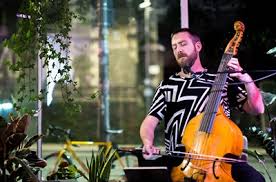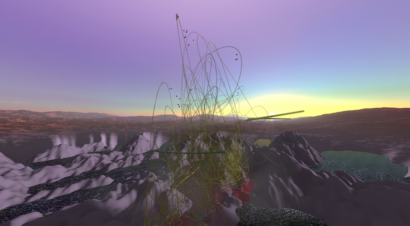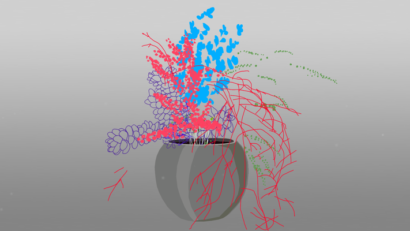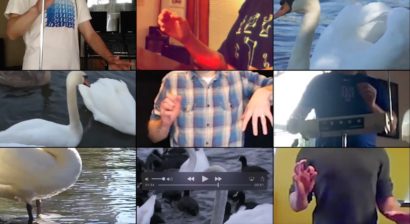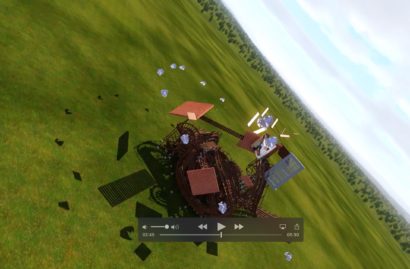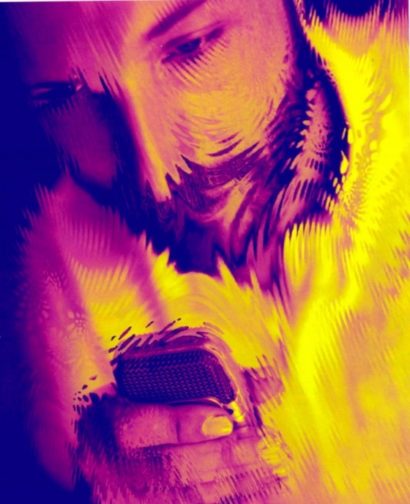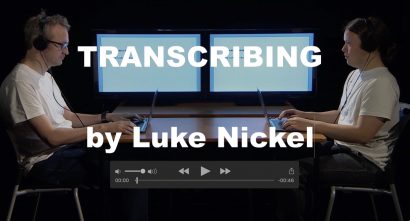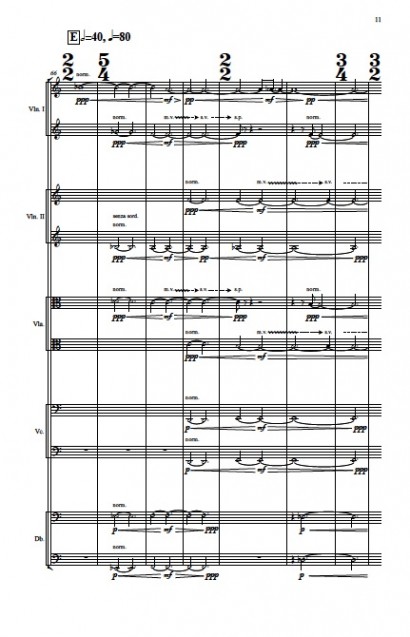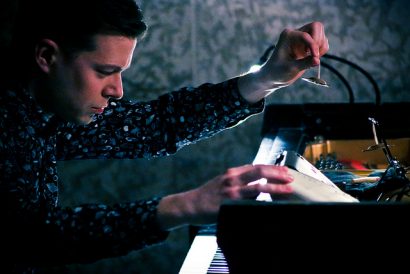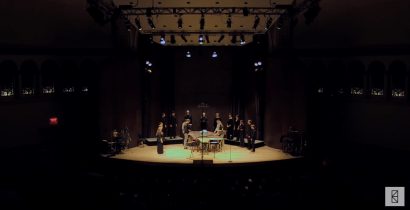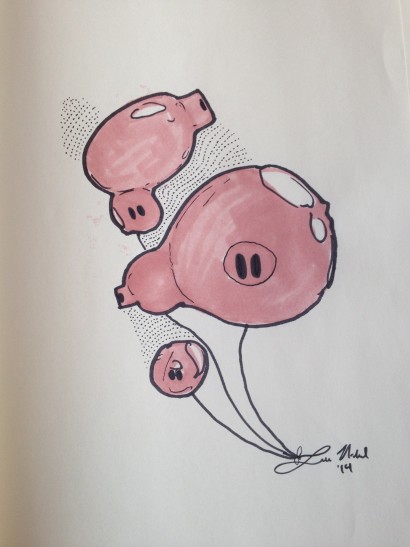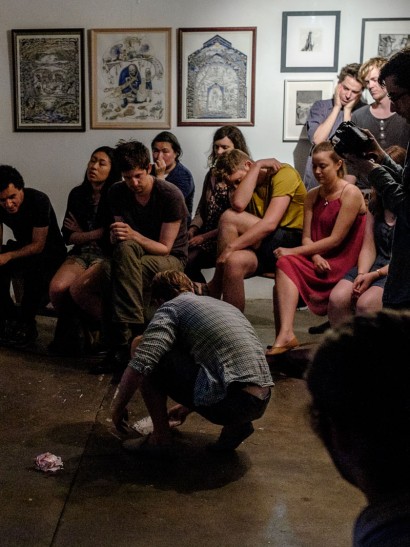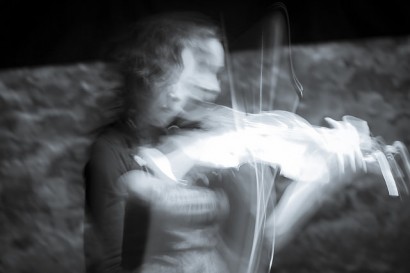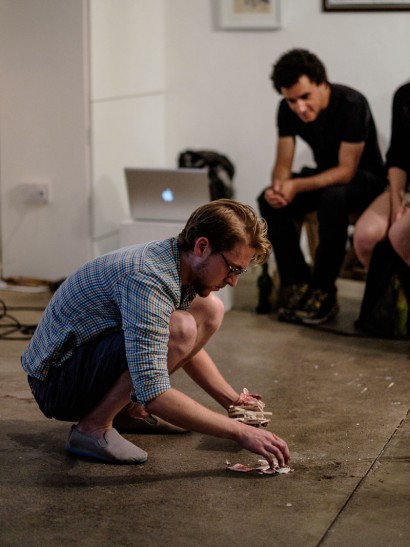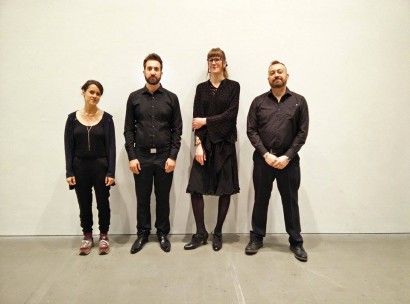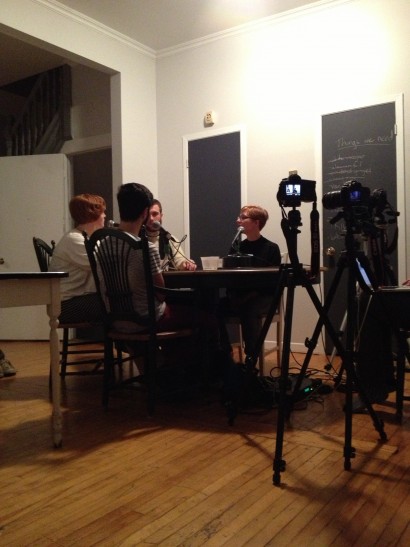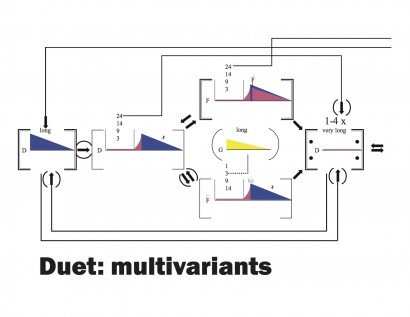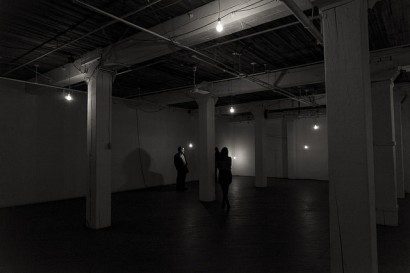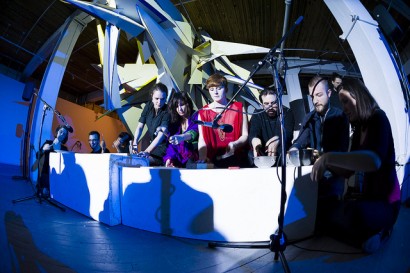hhiiddenn vvoorrttiicceess
Piano, electronics, 5 Soundbrenner watches, 2 strobe lights, video
15:00
2021
Created for Zubin Kanga as part of the Cyborg Soloists project
About
Simulated roller coaster velocities become metronomic pulsations passing through wireless connections to small vibrating watches cueing a pianist to press keys that hit hammers on strings… Swirling emotional currents snake through our subconscious, carrying the traces of voices, sometimes whispered, often thunderous: SOPHIE, Maurice Ravel and Anri Sala. Thank you to my collaborators: Zubin Kanga, Soundbrenner, holly+, Justin Focus, Jasper Sutherland and Tyler Marghetis.
More Info
blog post here: https://www.cyborgsoloists.com/news/roller-coaster-resonance
lecture here: https://www.youtube.com/watch?v=JRlbWIfqBjA
Performances
Acknowledgements
hhiiddeenn vvoorrttiiccess was created as part of the Cyborg Soloists project, in partnership with Soundbrenner.
Steel Becomes Silk, Gravity Recast
Living Score
Juliet Fraser, simulated roller coasters, video, electronic sound
15:00
2020
Created for Juliet Fraser
About
This is a roller coaster. It looms, it arches, it curls and twists…
This is a roller coaster project by multidisciplinary artist Luke Nickel and soprano Juliet Fraser, a 15-minute performance combining voice and simulated roller coasters commissioned by Huddersfield Contemporary Music Festival for performance in November 2021. In this collaborative piece, Juliet and Luke transform roller coasters into sound through a process of simulated gravitational witchcraft.
The piece is built through a process of conversation and experimentation. Juliet has created a roller coaster in her mind, and has sung its tracks, its speed, its height and its G-force. Luke has been constructing simulated roller coasters in a digital space, and has collaborated with A.I. to write a witchy spell. Nothing is notated. The emerging piece has a living score, embodied in the mind and the muscle memory.
In the performance, Juliet and Luke face each other on stage. Juliet sings an unearthly, timeless music born of crests, hills and loops. From a laptop, Luke creates a mesmerising digital landscape of writhing simulated roller coasters that are projected beyond the performers for all to see. A strange incantation — co-written with an artificial intelligence module (GPT-2) — describes a roller coaster, gives voice to the roller coaster, transforms itself and the listener into a roller coaster.
…Steel becomes hair and fingernails, joining with muscles and tendons, animal and human and metal…
Performances
- Nov 2021, Huddersfield Contemporary Music Festival: https://hcmf.co.uk/programme/hcmf-shorts-3/
Acknowledgements
Palace64 was created with the generous support of the Manitoba Arts Council. The roller coaster was created using NoLimits 2,
Cluster: Fictional Edition
Set of 37 images for digital display
Created for Cluster Festival XI: Digital Edition
About
I have been a co-director and co-curator of Cluster Festival for the past 11 years.
Cluster: Fictional Edition is a response to the cancellation of what would have been my final physical festival before handing the organization over to the brilliant Ashley Au.
In this space of absence, I have been thinking about festivals that weren’t. Festivals that might be or might have been. Imaginary spaces in the cracks between festivals.
The documentation images of Cluster: Fictional Edition were created using machine learning. I trained StyleGAN on over 1400 photos taken between 2010-2019 at various editions of Cluster Festival. StyleGAN learns the features of these photos, and creates a module that is trained to produce infinite new images that occupy the space between the original images. I have spent hours within this stream of images, blurring my eyes a bit, looking for those that feel the most like real performance situations.
To my eye, this collection of new images perfectly carries the DNA of Cluster. I can trace their component parts: a glittery curtain from Matthew Robin-Nye’s installation at Cluster 2018 becomes the robes of three mysterious performers; the LED lights that featured so heavily in Cluster 2010-2015 create a purple blue glow; ice from Gil Delindro’s installation at Cluster 2014 now covers the floor of a gallery; light stands multiply and become tangled… My memory can already make these pictures.
This is the Cluster of my dreams.
Exhibition
- May 2020 at Cluster Festival XI: Digital Edition online
Impossible Roller Coaster Tutorials 1-3
Standalone Video
27:00
1080p, 2 channel audio
2020
Created for CMHK
About
Showings
- October 15, 2020, Hong Kong Arts Centre, CMHK Sound Forms Festival
Acknowledgements
Impossible Roller Coaster Tutorials 1-3 was created with the generous support of the Canada Council for the Arts. The roller coaster was created using NoLimits 2, and the video was edited in Adobe Premiere Pro.
Cousins
living score
created for Liam Byrne (viola da gamba) and Émilie Girard-Charest (cello)
2019
About
Cousins highlights the contested lineage and relationship of the viola da gamba and the cello. The piece was created using the same orally transmitted instructions for both soloists. Each realization is unique despite carrying the same DNA.
Performances
- October 28, 2019, Buenos Aires, Émilie Girard-Charest (cello)
- October 12, 2019, Bristol, Cousins, Liam Byrne (viola da gamba)
Other Documentation
Liam Byrne performs Cousins
Autumn 2019: new piece for EXAUDI and more roller coasters!
Autumn is ticking away. At the moment I’m working on a Manitoba Arts Council-funded commission for EXAUDI in London. This piece takes as a starting point the vocal utterances of Glenn Gould while he plays his the Goldberg Variations. I am exploring ways of transforming these musical byproducts into beautiful blooms of choral texture.
I am also beginning research on a solo roller-coaster-building performance. I will use No Limits Coaster as an interface to both build roller coasters and create/perform live electronic music. I am excited to finally make something that I can perform myself!
Cousins – new piece
I’ve recently had the pleasure of developing a new piece for two solo performers at the same time. In this project, I worked with Liam Byrne, viola da gamba, and Émilie Girard-Charest, cello. Both performers received the same instructions, but the result is quite different.
Cousins explores the idea of these two instruments as related-but-different—twisted bloodlines, voices behind walls, overgrown forests… that sort of thing.
Liam has premiered his version of the piece in Bristol on October 12 at Glitch, and Émilie will premiere hers in Argentina at the end of the month. Then, in November, we will all get together in Berlin and see if we can make it into a solo. How exciting!
Palace64
Living Score
Unspecified Chamber Ensemble
8:00
2019
Created for Decibel New Music
About
In Palace64, I wanted to explore algorithmic roller coaster building. I created 20+ roller coasters using various formulae, which I imported as paths to Nolimits Coaster. Then, I created a custom 3D environment and shot countless hours of video, which I edited into what you see above! I wanted to evoke the idea of a post-human roller coaster environment reminiscent of a coral reef on an alien planet.
Musically, the piece consists of a pre-recorded track made up of a stretched out field recording taken at Thorpe Park as well as live acoustic instruments. I transmitted this piece to Decibel orally using a series of recorded spoken transmissions. During the performance, the musicians react to both the impossible virtual roller coasters on screen and mental and embodied memories of roller coasters—both real and imagined.
Performances
- July 25, 2019 by Decibel New Music at Monash University at TENOR2019 in Melbourne, Australia
Further Information
Acknowledgements
Palace64 was created with the generous support of the Canada Council for the Arts. The roller coaster was created using NoLimits 2, and the video was edited in Adobe Premiere Pro. Special thanks to Cat Hope.
Byl-ka
Sound Design + Music
2019
Game/installation by Darko Masnec
About
I created the sound design and music for a new game by Dark Masnec! The object of the game is to grow a beautiful set of plants through adjusting various numerical parameters. I created a number of electronic audio tracks that represent the plants so that each time you play you get a different shifting soundscape.
“Byl-ka is envisioned as a set of possible digital translations of the herbal world and how the concept of flora can be redefined in a digital surrounding. In a simple interface, we can see empty planter and five elements. The elements we can manipulate with are in control of growth, appearance, and life of the plant. Light, color, transparency, sound, attention, and combination of these five elements are a base to cultivate your digital plant. Each element can reach a value of a maximum of 100 points. The player is trying to find balance among all of the elements to achieve homeostasis: the optimal conditions needed to reveal the plant. There are more than 8 billion different possible combinations of intertwined elements.
https://darkomasnec.itch.io/byl-ka
Dive Deep in Blue, My Sweet
Traditional Score
Flute, Clarinet in Bb, Violin, Cello, Percussion, Piano, Tape, Video, Conductor and Amateur Theremin
9:30
2018-2019
Created for TAK Ensemble
About
Dive Deep in Blue, My Sweet is a weird water world—a queer puddle through which we can just about make out an infinity mirror made of youtube videos, warbled strains of familiar classical music, strange bird calls and stranger songs. Nothing is quite as it seems here… put your white tennis shoes on and follow me.
(dedicated to Linda Catlin Smith and Cassandra Miller)
Dive Deep in Blue, My Sweet relies on the virtuosity (and generosity!) of performers. For the most part, they perform as individuals (or duos), contributing to a greater sonic environment. The conductor never beats time (beyond potentially giving cues) or indicates expression, but instead acts as a facilitator for the entries and exits of instruments. Partway through, the conductor is even waylaid into playing the theremin!
Performances
- March 30, 2019 by Continuum as part of PIVOT 2019 (hosted by the Canadian League of Composers) at the Music Gallery, Toronto
Acknowledgements
Dive Deep in Blue, My Sweet was created as a part of PIVOT 2019 (hosted by the Canadian League of Composers)
For a copy of the score please contact me.
Summer Research / New Tempo Article
This summer I will be returning to the work of Éliane Radigue for a new article for TEMPO. I will be researching Éliane’s amazing work in the context of other practitioners—both composers and performers—who also work in an orally-transmitted compositional setting. Once again I will focus on interviews with performers to provide the majority of the content of the article. This will be published in Dec. 2019.
Hopefully alongside I will be working with at least one new soloist on a new living score. Word on the street is that I may be collaborating with the fabulous Liam Byrne (viola da gamba) and Émilie Girard-Charest (cello)… rumour has it there may even be a Bristol performance in the pipeline!
Moonriver32
Traditional Score
Unspecified Chamber Ensemble (at least 4 instruments) + solo amplified voice + tape + video
5:00
2018-2019
Created for TAK Ensemble
About
Moonriver32 is dedicated to the memory of my aunt, Patricia Bouk. This piece draws inspiration and material from a number of sources: a recording of a dying carousel playing Moon River, Audrey Hepburn singing the same iconic song in Breakfast at Tiffany’s, my early teenage experience designing roller coasters… The video in Moonriver32 depicts an impossible roller coaster… a kind of whimsical yet nightmarish Audrey Hepburn-themed thrill ride. When I designed roller coasters at an early age, I was concerned with realism. Now, fifteen years later, I am more inspired by conceptual art and Disney’s Imagineering than real world physics….
Performances
- March 2, 2019 at the Cluster: New Music + Integrated Arts Festival, TAK Ensemble (Winnipeg, MB)
Acknowledgements
Moonriver32 was created with the generous support of the Canada Council for the Arts. The roller coaster was created using NoLimits 2, and the video was edited in Adobe Premiere Pro.
A Hushed Workshop
Living Score
Solo Instrument
Open Duration
2018
Created for Heather Roche
About
A Hushed Workshop was created in collaboration with Heather Roche during Autumn 2019. The piece centres around the oral transmission of descriptions of numerous conceptual machines inside an imaginary workshop. Roche wrote an article about the piece that was featured in Musicworks Issue 132, and a few phrases can be found below:
Luke Nickel has left me a series of sometimes vague, sometimes specific instructions via audio recordings of his voice, which I am only allowed to listen to once, so that I may create a piece… By relying on the creative imagination and memory of the performers he works with, Nickel’s work embodies an ideal form of performer-composer collaboration… He puts an enormous amount of trust in the performers of his music… Luke’s voice is calm as he explains how the process will unfold. His voice is relaxing to listen to, and it already feels like the process of creating the piece will be something for just us, something rather intimate.”
The following recording was recorded by Simon Reynell of the Another Timbre label at the Music Room in South London, and it first appeared in Musicworks Issue 132. Photo credits go to Sam Walton.
Performances
A Hushed Workshop has not been premiered yet—if you’re interested in booking a performance, please contact Heather Roche or myself.
Acknowledgments
I acknowledge the support of the Canada Council for the Arts.
TENOR 2019 Conference
I am very pleased to announce that I will be presenting a new piece and paper at TENOR 2019 in Melbourne, Australia. In July 2019 I will be heading to Monash University to work with Decibel New Music Ensemble on a new piece. This will be another impossible roller coaster piece and, for the first time, I’ll be presenting some written research alongside it.
Algorithmic Roller Coaster Building
In a fantastic turn of events, I’m learning how I can export roller coaster track as CVS files. This means that I can effectively turn a roller coaster into data. This is quite fun, because it means that now I can manipulate numbers (in ways that are much more difficult in the hand-built nature of the editor) and import them back as track.
I’m currently experimenting with algorithmically generating roller coaster track. I guess my goal is to make an even more impossible track… something that defies all expectations. Below are a few examples of some initial attempts at building tracks using data manipulation rather than hand-building techniques.
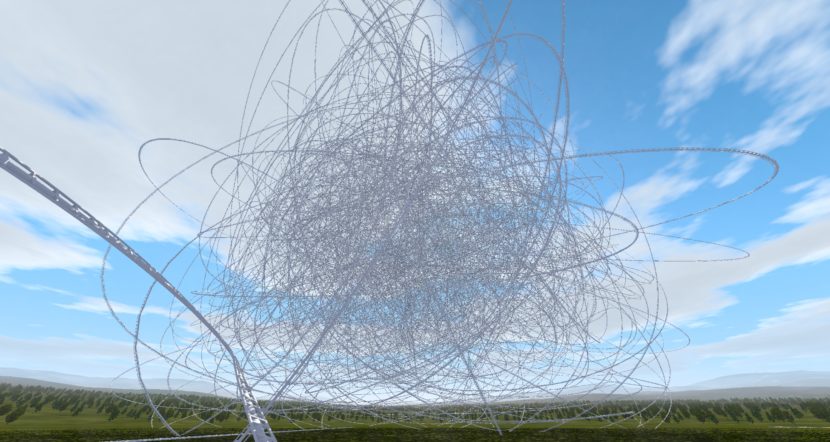
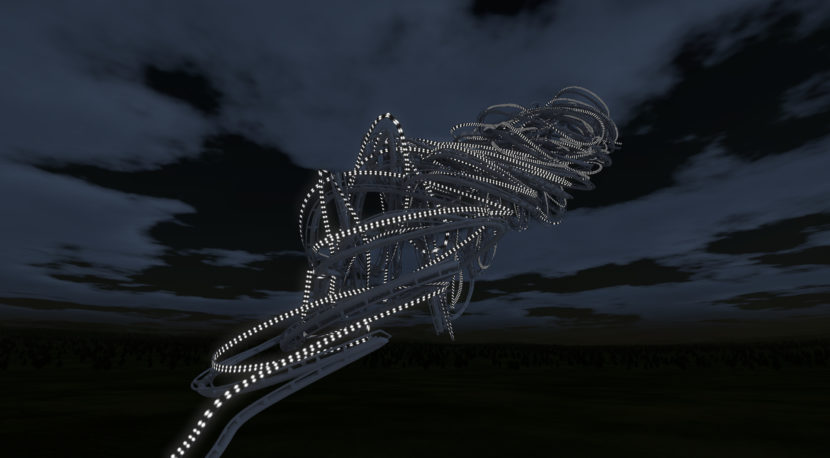
Watch Online: Luke Nickel University of Oxford Lecture
Check out a recorded livestream of my University of Oxford lecture from November 2018.
Roller Coaster Research Continues!
I am very lucky to have received funding from the Canada Council for the Arts to continue my research on the intersection of impossible roller coasters and music. This will take the form of two projects. The first will be a work for TAK Ensemble. In this piece, I will create a roller coaster accompaniment to a piece of chamber music. In the second piece, written for Decibel New Music in Melbourne, I will create a video score for the ensemble.
I’m feeling very fortunate to be working on something that is essentially a childhood dream of mine!
Musicworks Issue 132: Article
I have been featured in Musicworks Issue 132 in a lovely piece written by Heather Roche. In her article, Heather discusses collaborating with me on an orally-transmitted composition entitled A Hushed Workshop. She really gets to the heart of working in a pretty unusual manner. The article also features a few excellent (heavily edited) photos by Sam Walton, as well as a gorgeous recording of the piece care of Simon Reynell (of Another Timbre).
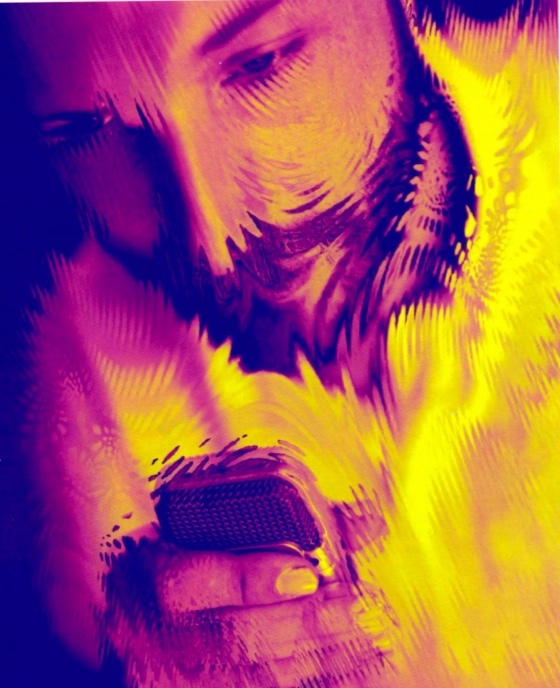
String Trio #1: Norwegian Tour
James Saunders, Tim Parkinson, and Michael Duch will be touring a new piece I have created for them, String Trio #1. This piece is pretty similar to my String Quartet #1, except that it is a transcription of a piano, violin, and double bass trio (not exactly a string trio… but I like the continuity in names). Parkinson/Saunders/Duch will play the piece in a few different places. If you’re in Norway, be sure to check it out!
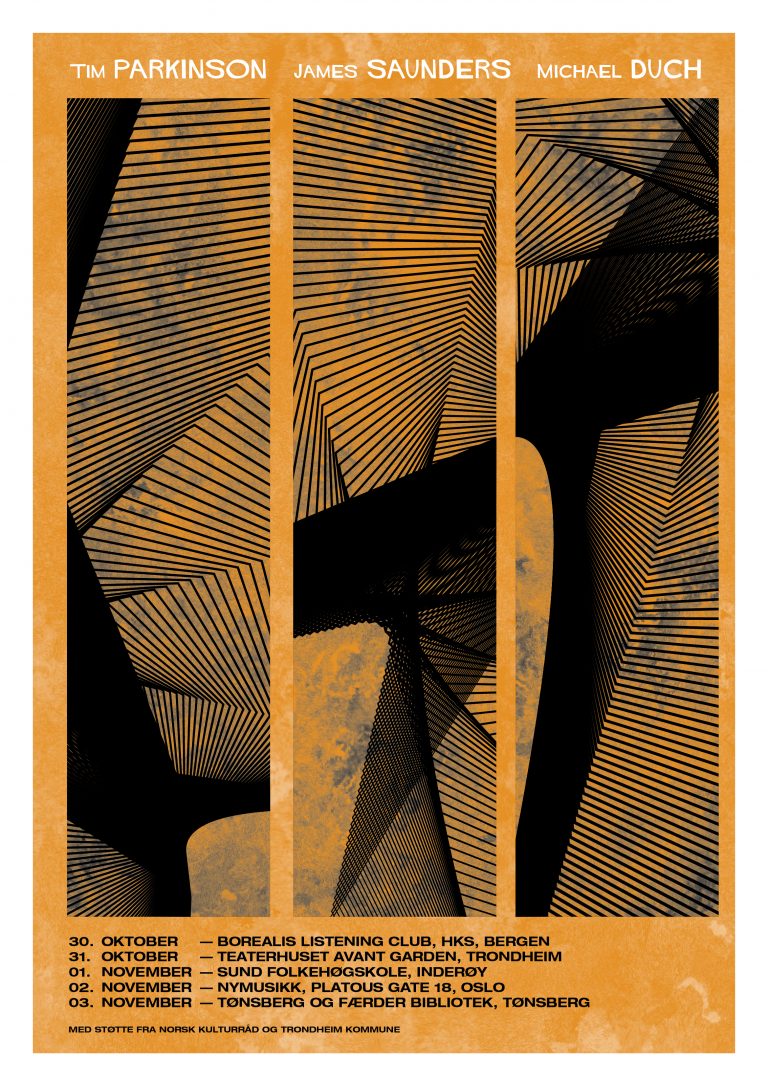
PIVOT scheme 2018/2019
Very pleased to announce that I’ll be joining the Canadian League of Composers‘ Pivot Scheme 2018/2019. This means that over the course of the next six months I’ll be writing a new piece for Continuum ensemble in Toronto, which will be performed once in Toronto and once in Montreal in Spring of 2019. I’ll also receive mentoring from an as-of-yet-unchosen composer throughout the year. I’m very excited about this… I’ve wanted to work with Continuum since I was a teenager! Stay tuned for updates and early research for the piece… all I can say is that right now I’m thinking theremins (though that might change!)
More information on the other fabulous Pivot participants here.
Lecture at University of Oxford
On Thursday, November 8th I will be lecturing at the University of Oxford about my recent music alongside Marco Donnarumma. It’s a huge honour to have been asked to deliver this lecture, and I’m looking forward to delving deep into the recent directions I’m heading in…
More information here.
SOCAN Foundation Award
Pleased to announce that my work String Quartet #1 won a 3rd prize in the SOCAN Foundation Awards for Young Composers. I had previously thought my work was maybe too strange to win awards anymore, but this has me reconsidering!
The rest of the winners can be found here.
Transcribing
Two Performers (laptops/keyboards, amplification, and projection)
Open Duration
2017
Created for the Parkinson/Saunders Duo
About
Transcribing is a piece for two typists. During the performance, both typists transcribe (audio → text) the same archival audio material. Though they each only listen to their own audio track, the audience hears both layered on top of each other. Because the act of transcription involves pausing and rewinding the material to accurately type it, the audience hears a stratified, looped, fragmented, and stretched version of the original audio recording that gradually reveals the source material.
This piece was originally developed for the Parkinson Saunders duo for BBC’s ‘Hear and Now’, and has been recorded in three different versions using different source materials. The video on this page features Alex Mah and James Saunders, and was recorded at the Bath Spa University TV Studio as a part of Open Scores Lab. The video was cut together by myself, and features archival material from www.archive.org and a found cassette from Sweet Thunder.
Performances
- July 2018, Luke Nickel and Jennie Gottschalk, MonkeySparrow (online)
- January 2018, Alex Mah and James Saunders, Bath Spa TV Studio (recording)
- October 2017, Parkinson Saunders Duo, BBC Hear and Now at the Wellcome Collection (London, UK)
Other Documentation
aaadagio
Traditional Score
String Orchestra (55432)
11:00
2017
Commissioned by the Manitoba Chamber Orchestra
About
For the last three years, I have not written a single note of music. Instead, I’ve made pieces collaboratively with musicians using any means except musical notation. I’ve made pieces that consist solely of orally-transmitted descriptions of an imaginary factory. I’ve made pieces that chew up existing music and spit it out into tangled new configurations. I’ve made pieces for art galleries that contain only speaking, not a note of music to be heard.
This piece for the Manitoba Chamber Orchestra marks my return to traditional musical notation. But with it I bring the great joy and endless possibility that I found using these other compositional methods.
In writing for the MCO, I have chosen to use Barber’s Adagio as a source material. I’ve always been intrigued by the first musical phrase of the piece: the succulent chords, the sense of floating tension…
I like to imagine Barber’s Adagio as a great ship that sails calmly through our collective subconscious. In my piece, aaadagio, we listen to what lies beneath the behemoth ship. What turgid melodies swirl through the deep? What creaking sounds does the ship make while weathering a storm? How does light sound when it glints on the water.
A former composition teacher would often jokingly ask me what the effect would be if I used Barber’s Adagio to end of one of my compositions. This piece is my answer.
(aaadagio is dedicated to Chris Paul Harman, to whom I owe my love of musical provocation)
Performances
- April 26, 2017, the Manitoba Chamber Orchestra (Winnipeg, MB)
Acknowledgements
I acknowledge the support of the Manitoba Arts Council and the SOCAN Foundation
For a full score or recording, please contact me
Impossible Roller Coasters
Big things are afoot.
After about a year’s gestation, I have begun to continue my research into impossible roller coasters (and their possible links to music). To recap: last spring, I spent a one week residency at the Arnolfini in Bristol, UK. During my week there, I endeavoured to make a “realistic” roller coaster. I visited the same online forums I used to design roller coasters when I was a young teenager, and tried to hold myself to the same level of technical prowess.
Well, spoiler alert… I couldn’t do it anymore! Somehow my technical capabilities have dwindled. Or I am just not as interested in making realistic roller coasters. I was very lucky though in that a friend and fellow composer/performer Dominic Lash visited me on the final day of my residency. He remarked that, while the “realistic” roller coaster would make a pretty boring score, an impossible roller coaster would make a more interesting one.
I am spending some of this summer making small forays into impossible roller coaster design. I am particularly interested in knots and tangles. It will be very interesting to see where this all leads…!
Experimental Music Since 1970
Some months ago, Jennie Gottschalk’s wonderful Experimental Music Since 1970 was released. This book is—so far—the only resource of its kind, attempting to map out some of the conceptual orientations of the current field of experimental music. Jennie provides countless examples of unusual practices from around the world, and the writing is lush and descriptive.
I’m very pleased to be included! You can find some writing about my work on pages 216-217. Here’s a little quote about my work Made of my Mother’s Cravings:
In both recorded performances, there is an unusual quality of rawness. The players are participating in an oral, folkloric tradition without any sense of irony or fl ippancy. Each player is working hard to project something that is already internalized. The interaction among the players is not simply about execution, but about content, and about diff erences in perception between each of them.
Purchase the book here.
Research
Current Research
My current research interests are: orally-transmitted experimental music; the music of Éliane Radigue; impossible roller coaster simulations; memory; queer identity; gravity and music; and and machine learning. For publications, scroll down!
I am currently working on: a new VR installation with Dr. Tyler Marghetis exploring foraging in apes as related to human art-making across multiple timespans; research with Freya Olafson on the connection between avatars, movement, gravity, and music; research with Sade Abiodun on artificial intelligence, dreams, and neuroasthetics; and a year-long research project on music and artificial intelligence.
Impossible Simulated Roller Coasters
Before I became interested in music creation, my first love was designing roller coasters. At an early age, I began using a 3D roller coaster design program called No Limits (sometimes used by professional companies for creating mockups of their designs). Growing up in Winnipeg, I designed roller coasters before ever having ridden one in real life.
Fifteen years later, I am exploring a rich potential for merging these two interests in my life. I am interested in the idea of an ‘impossible’ roller coaster. How can the design features of a roller coaster experience become abstracted? What might it mean for a lift hill or a ‘drop’ to go on forever, for a track to be a tangled knot of sculptural potential, for a roller coaster to float in endless space? And finally, how can this impossible roller coaster ‘language’ relate to music?
Publications (forthcoming)
Contemporary Music Review Special Issue on Éliane Radigue (2023)
I will be co-editing a special issue of CMR with Bill Dougherty featuring scholarly articles and reflections on the incredible music of Éliane Radigue.
Publications
Queer Perspectives in New Music
Enquête: Queer Perspectives in New Music in Circuit 31.1 (Spring 2021)
In this new article I discuss my queer identity as it relates to music relation in a small article edited and curated by Gabriel Dharmoo.
Scores in Bloom: Some Recent Orally Transmitted Experimental Music
Tempo New Music Journal
A small group of composers and performers are collaborating orally/aurally on the creation of experimental music that eschews written scores (‘living scores’). By charting the overlaps between working methods and relationships – both social and musical – this article endeavours to shed light on how these practices rub against standard modes of documentation, transmission, scholarship and performance. The article begins by mapping out of the orally transmitted collaborative practices of four composers – Cassandra Miller, Pascale Criton, Éliane Radigue and me – as documented through interviews with prominent performer-collaborators such as Deborah Walker, Silvia Tarozzi, Juliet Fraser and Cat Hope. A guiding metaphor frames these practices as gardens and highlights shared thematic concepts such as extended time, hospitality, note-taking and responsibility.
Palace64: Impossible Roller Coasters as Scores for the Performance of Experimental Music
Proceedings of the International Conference on New Tools for Music Notation and Representation (TENOR’19), Melbourne, 2019 (July 2019)
In Palace64, a major new multidisciplinary project combining video and chamber ensemble, I examine the ways in which the domains of music composition and virtual roller coaster design might influence one another. First, I briefly discuss existing artistic projects relating to roller coaster design. Second, I present my own early artistic explorations combining music and virtual roller coasters. Finally, I discuss Palace64. In this project, I create a new medium of score that combines oral transmissions describing imaginary impossible roller coasters with videos created using innovative 3D roller coaster design software (NoLimits 2). Using strategies pioneered by Éliane Radigue and Jennifer Walshe for interpreting imagined images and paths as musical material, I develop ways in which performers can “read” these impossible roller coasters—remembered and virtual—as scores. Ultimately through this project my goal is to create and demonstrate a hybrid artwork that exists not only as a score to facilitate the performance of experimental music, but also as a conceptual theme park ride that traverses the boundaries of possibility and impossibility in a region that marries the digital with an embodied human experience of risk and pleasure. This paper is intended as an accompaniment to the performance of Palace64 by Decibel New Music Ensemble.
Occam Notions: Collaboration and the Performer’s Perspective in Éliane Radigue’s Occam Ocean
Tempo New Music Journal
After nearly 40 years of creating recorded electronic music, for the last 10 years Éliane Radigue has created music exclusively in collaboration with performers, using solely oral and aural transmission. Focusing on the details of this ‘scoreless’ working method, this article considers the performer’s perspective on Radigue’s Occam Ocean (2011–), a series of 22 infinitely combinable solos and over 20 chamber pieces. Through interviews with the performers and Radigue, a composite understanding of their collaboration is reached, focusing on the emergent ideas of virtuosity, memory, images, scores, hospitality and non-hierarchy. A typical transmission and collaboration is described, and a new lens for viewing this method is proposed, the living score. The article concludes with a brief discussion of how Radigue and her collaborators’ non-hierarchical model of collaboration may offer an alternative compositional framework.
Memory Piece: Memory as a Compositional Process
Leonardo Music Journal
The author describes the use of memory as a compositional process in his recent orally and digitally transmitted compositions.
Correspondance on Tuning – Mira Benjamin and Luke Nickel
CeReNem Journal
Mira Benjamin and Luke Nickel share thoughts on portraiture, space, and metaphors about tuning.
PhD Thesis
In August 2017 I formally completed my PhD at Bath Spa University. My abstract can be found below:
This commentary reflects on a portfolio containing five of my recent orally-transmitted experimental music compositions created between fall 2013 and fall 2016. These living scores investigate transmission, community, orality and forgetting, which are the major themes of my original work. This commentary relates particularly to two main research questions: 1) what happens to the traditional practices and relationships surrounding composers and performers if the material aspect of the musical score is removed; and 2) what musical materials and processes are particularly suited to an orally-transmitted compositional method?
After a brief introduction in Chapter 1, Chapter 2 provides context to the portfolio, exploring the terms experimental music and living scores. The term living scores has been used by a variety of artists in contexts ranging from dance collaborations to digital media. A new definition of living scores is proposed based on a synthesis of these existing uses to mean contexts in which all compositional instructions are transmitted, rather than fixed. Living scores are essentially participatory – they foreground collaboration and encourage the formation of micro-communities. Because they eschew written notation, living scores allow the act of forgetting to become a vital part of the creative process. Composers such as Éliane Radigue, Meredith Monk and Yoko Ono are discussed in this new context.
Chapters 3 and 4 discuss my work within the paradigm of living scores. In Chapter 3, after a typical transmission of my work is outlined, aspects of oral and digital transmission are detailed, including the media, length, density and frequency of transmissions. Many of these aspects are discussed in relation to the act of forgetting, which through this creative work can be seen as a productive feature of artistic creation. In Chapter 4, the musical material of the portfolio is discussed, with an emphasis on the use and transformation of borrowed musical source material. A solution for the integration of the collaborative process into performances of these works is proposed: partial transmissions overlapping with performances.
A brief conclusion outlines the possibility for future research that explores other modes of transmission, further musical explorations and repeated use of this compositional method.
The full thesis can be found here.
List of Works and CV
Below you can find links to my current list of works (including performances!) as well as my professional CV.
BBC Hear and Now
I had the good fortune to present a new piece on BBC’s “Hear and Now” program in London, UK on October 14, 2017.
The piece was created for the Parkinson Saunders Duo, and is a new strand of research that involves performers transcribing texts live on stage to create erratic looping soundscapes.
https://www.bbc.co.uk/music/artists/295abe7f-220c-4eca-9cd8-2494903fed0c
Featured in the Wire Issue 403
Recently, Tim Rutherford-Johnson (whose well-known blog has been a favourite of mine for a long time) interviewed me for an article in the Wire. Tim’s article (Unsettling Scores) is about embodied scores, and features some great writing about composers such as Celeste Oram, Claudia Molitor, Michael Baldwin, and Louis d’Heudieres.
Here’s a small quote about my work:
With any written record destroyed, they have to rely on their memories and Nickel’s own instructions for disseminating its contents to others, creating a new, socially networked form of composition. Nickel distributed instructions through soundfiles, “little radio broadcasts” in which tone of voice, vocal cadence and “vibe” are compositional parameters. Some of these could be listened to more than once; others would have to be deleted, Mission Impossible-style, after hearing.
Arnolfini Residency March 27-31
This week upcoming I will be engaging in a short residency in the Dark Studio of Arnolfini in Bristol, UK.
I’ll be developing a new project themed around on-ride videos of rollercoasters. I used to be very interested in rollercoasters as a teen, and when I checked to see if my simulator of choice had a new version, it did! Enter No Limits 2
In the gallery I’ll spend the week building simulated rollercoasters and thinking about what the intersection of art and rollercoasters might be, whether I should design something “realistic” (and what that even means), what role process might have in my design, how online communities and critique might influence my thinking and—because I’m a composer—how live musicians might interact with the project as a kind of score or environment.
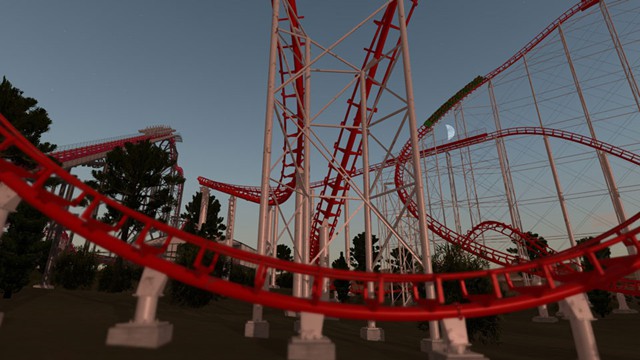
(example track from the No Limits website showing what the sim can do!)
Oshima
Living Score
Solo Piano
Open Duration
2017
Commissioned by Everett Hopfner
About
Oshima, which Hopfner learned in a series of late-night radio transmissions, sonically sketches a character from Murakami’s Kafka on the Shore in a sparse deconstruction of jazz and darkness.
Performances
March 12, 2017, Cluster: New Music + Integrated Arts Festival by Everett Hopfner (Winnipeg, MB)
Other Documentation
Full performance recording live from Cluster Festival
Revisiting Murakami…
In recent months, I have had the pleasure of creating a new piece for (and with…) Manitoban pianist Everett Hopfner. The piece examines the character of Oshima from Murakami’s Kafka on the Shore. Oshima is a very organized librarian who serves as the pivotal axis around which all supernatural events in the novel seem to flow. He fields characters toward each other, toward locations, and toward the surreal—but he never participates himself. Oshima has a kind of considered calculation but a considerable amount of heart. I was very inspired.
I create Oshima with Hopfner by way of late-night radio-style vocal transmissions. I explained aspects of the piece to Hopfner, who only listened to them once before assimilating the information into his understanding of the piece. In the final rehearsal before the performance, Hopfner’s own understanding of the piece far surpassed mine—just how I like it!
Oshima was premiered on March 12, 2017 at the Winnipeg Art Gallery during the Cluster: New Music + Integrated Arts Festival. An image can be seen below, and a recording should be available soon.
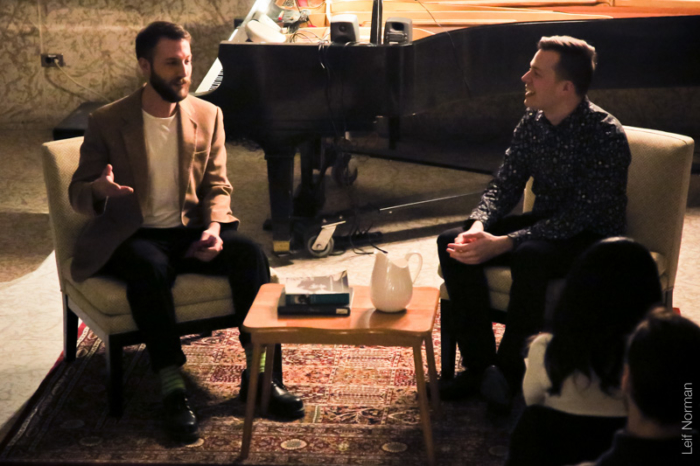
(me with Hopfner, photo care of Leif Norman)
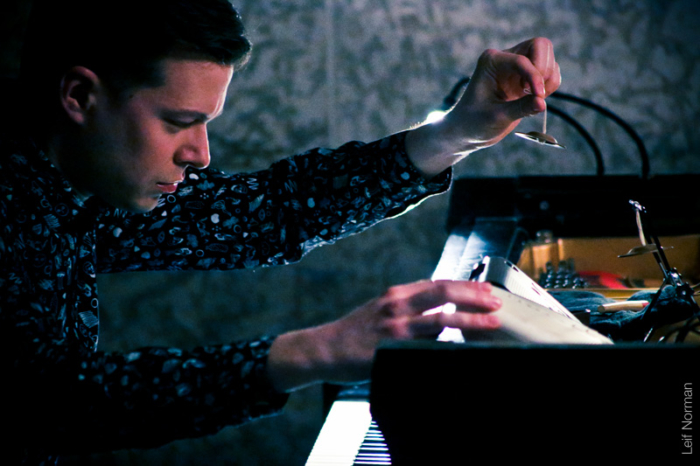
(Hopfner performing the piece with many bells and whistles, photo care of Leif Norman)
New piece for the Manitoba Chamber Orchestra
During December 2016 and January 2017 I wrote a new piece for the Manitoba Chamber Orchestra. The piece, entitled aaadagio, is a re-imagining of Barber’s Adagio for Strings… or at least, the first three chords of it. I’ve included a program note below, as well as a picture of one page of the score. You can hear the performance in Winnipeg, Manitoba on April 26, 2017. This piece was made possible by the generous support of the Manitoba Arts Council.
Program Note:
For the last three years, I have not written a single note of music. Instead, I’ve made pieces collaboratively with musicians using any means except musical notation. I’ve made pieces that consist solely of orally-transmitted descriptions of an imaginary factory. I’ve made pieces that chew up existing music and spit it out into tangled new configurations. I’ve made pieces for art galleries that contain only speaking, not a note of music to be heard.
This piece for the Manitoba Chamber Orchestra marks my return to traditional musical notation. But with it I bring the great joy and endless possibility that I found using these other compositional methods.
In writing for the MCO, I have chosen to use Barber’s Adagio as a source material. I’ve always been intrigued by the first musical phrase of the piece: the succulent chords, the sense of floating tension…
I like to imagine Barber’s Adagio as a great ship that sails calmly through our collective subconscious. In my piece, aaadagio, we listen to what lies beneath the behemoth ship. What turgid melodies swirl through the deep? What creaking sounds does the ship make while weathering a storm? How does light sound when it glints on the water?
Full disclosure: I’m writing this description before I’ve written the piece, let alone heard it! So, please consider this a statement of intent, and forgive me if the piece you’re about to hear doesn’t quite match what you’ve read.
In short:
A former composition teacher would often jokingly ask me what the effect would be if I used Barber’s Adagio to end of one of my compositions. This piece is my answer.
(aaadagio is dedicated to Chris Paul Harman, to whom I owe my love of musical provocation)
Finished PhD!
I have recently completed my PhD, more info about which can be found on the “Research” page of this site. This might explain the lack of news and new pieces on my website… I’ve basically spent the last 9 months writing, submitting, and defending the PhD. More to come!
Open Scores Lab / Glenn Gould
I am testing out a new idea for a choral piece centred around recordings made by Glenn Gould. I had the opportunity to try it within the context of James Saunders’ Open Scores Lab. Below is some text from the accompanying lab report (written by James) as well as videos for context.
For the rest of his session, we worked on a new piece by Luke, provisionally titled after Glenn Gould. The piece involves a group of performers watching a film of Glenn Gould’s 1981 recording of Bach’s Goldberg Variations and listening through headphones. The audience only see the performers and do not experience the source material directly. The performers mimic Gould’s mouth shapes and quietly echo his singing, but only when his mouth is visible. As with Luke’s other pieces, this brings a hidden layer to the fore.
We tried two versions of the piece: once with just the trio (James Saunders, Louis d’Heudieres, Caitlin Rowley), and once where we were joined by Michael Winter reading from a text, in this case White Fang again, using the same methods as in Literary Field Recording. The situation for the performer is complex, trying to distinguish the moments when Gould’s mouth is visible (he often turns away from the camera or ducks down behind the piano) in order to begin singing. Given the low volume level of both Gould’s singing and that of the other two performers’ sung echoes, distinguishing who is singing is also somewhat difficult. I was also very much aware that my experience of the piece was very different, given my exposure to the piano playing in addition to Gould’s singing and our group response. In this way, Luke and Louis’s work have some correspondence, presenting hidden materials in a way that makes their function clear for the audience. I like this element of translation very much.
who’s exploiting who
Living Score
Chamber Ensemble
Open Duration
2016
Commissioned by the Thin Edge New Music Collective
About
I developed Who’s Exploiting Who collaboratively with the Thin Edge New Music Collective in January and February 2016. There is no written score for the piece, and as a result it relies entirely on the ensemble’s collective memory to be realized.
Before each TENMC rehearsal, I corresponded individually with every member of the ensemble via a temporary audio file that I posted privately on soundcloud. These correspondences contained recordings of my voice describing musical parameters, metaphorical text and logistical instructions. During rehearsals, the ensemble patched together a collective understanding of the piece based on their individual memories of the original correspondences. I was not present for rehearsals, thus allowing the resulting constellations of their new insights to supersede my original artistic impulses.
Who’s Exploiting Who is based on one of my favourite songs released in 2015 — Exploitation by Roísin Murphy. I fed various musical fragments of the original song through my somewhat scattered memory as well as the (less scattered) memory of the TENMC. The result is (hopefully!) a kaleidoscopic and hallucinogenic exploration of complete musical obsession.
Roísin seems to like the arrangement…
Performances
- February 16, 2016 at ArrayMusic by the Thin Edge New Music Collective (Toronto, ON)
smokescreen
Living Score
SATB Choir + Percussion
Open Duration (c.a. 10 minutes)
2016
Commissioned by Architek Percussion and Viva Voce
About
Smokescreen is an orally-transmitted piece created in collaboration with Architek Percussion and Viva Voce in Montreal.
To create the piece, I used a late 14th century work by Solage (fumeaux fume par fumée) as the source material. This mysterious and beautiful motet is stretched into glacially slow intervals punctuated by hazy static and shimmering choral resonances (how’s that for a program note!)
Performances
- January 17, 2016 at Salle Bourgie, Architek Percussion and Viva Voce, Directed by Peter Schubert (Montreal, QC)
- April 4, 2016 at Sala Rossa, Architek Percussion (Montreal QC)
Acknowledgements
I acknowledge the support of the Canada Council for the Arts.
Occam Notions: Collaboration and the Performer’s Perspective in Éliane Radigue’s Occam Ocean
My article on the fabulous collaborative compositions of Eliane Radigue has been published in the January 2016 version of TEMPO new music journal. Abstract and link below:
After nearly 40 years of creating recorded electronic music, for the last 10 years Éliane Radigue has created music exclusively in collaboration with performers, using solely oral and aural transmission. Focusing on the details of this ‘scoreless’ working method, this article considers the performer’s perspective on Radigue’s Occam Ocean (2011–), a series of 22 infinitely combinable solos and over 20 chamber pieces. Through interviews with the performers and Radigue, a composite understanding of their collaboration is reached, focusing on the emergent ideas of virtuosity, memory, images, scores, hospitality and non-hierarchy. A typical transmission and collaboration is described, and a new lens for viewing this method is proposed, the living score. The article concludes with a brief discussion of how Radigue and her collaborators’ non-hierarchical model of collaboration may offer an alternative compositional framework.
http://dx.doi.org/10.1017/S0040298215000601
the strange eating habits of Erik Satie
Living Score
SATB Choir
Open Duration (c.a. 10 minutes)
2014-2015
Commissioned by EXAUDI
About
I developed The Strange Eating Habits of Erik Satie collaboratively with James Weeks and the EXAUDI vocal ensemble in London, UK as a part of Sound and Music’s Portfolio scheme. The piece was created in several meetings occurring over the course of a year (2014-2015). There is no written score for the piece, and as a result it relies entirely on the ensemble’s collective memory to be realized.
Before each meeting, I corresponded individually with every member of the ensemble via a temporary audio file that I posted privately on soundcloud. These correspondences contained recordings of my voice describing musical parameters, metaphorical text and logistical instructions. During rehearsals, the ensemble patched together a collective understanding of the piece based on their individual memories of the original correspondences. I silently watched, often allowing the resulting constellations of their new insights to supersede my original artistic impulses.
The manner in which the piece transforms and decays continually over time is reflected in my musical dismantling of the work’s source material: Erik Satie’s Choral Inappetissant from his Sports and Divertissements (originally written for piano).
Performances
- October 17, 2015 by EXAUDI (London, UK)
Acknowledgements
I would like to acknowledge the support of Sound and Music in the creation of this work.
Matthew Lee Knowles // Points, Lines, Frogs and Kumquats
Matthew Lee Knowles made a video featuring some of my drawings! In it, Matthew deploys a sonic process while creatively reframing/revealing my drawings. I love how as the video goes on and the sound gets dreamier, the framing gets more extreme and stretched out. Check it out!
Pour répondre à le demande de Julien // Eliane Radigue
A small quote which I’ve translated from Eliane Radigue’s article of the same name found in Portraits polychromes no. 17 relating to her extraordinary oral practice of transmitting pieces. It’s quite beautiful in the original French…
How does it work? By the mysterious power of the projection of ideas that inhabit the spirit of the work and which determine the work’s structure; images projected either by words or intuitively/abstractly, associated with a hint of the intellectual, the same nature of the music, transported as if by magic in a way that eastern thought calls “heart to heart” (the location of the spirit in these cultures), which here in the west we have had the tendency to situate after having mentalized, stripped of affect, in the brain”
– Eliane Radigue “Pour répondre à le demande de Julien” in Portraits Polychromes no. 17
Michael Baldwin [Factory] Interview
As mentioned in previous posts, I’ve had the good fortune of having Michael Baldwin perform [Factory] twice in the last year. Michael’s just posted about his second performance. Read it here.
Extending from a tradition of verbal scores using text and language to communicate ideas for making music, Nickel’s [factory] is unique in the way its musical and artistic ideas are communicated. As a part of a larger project, Luke has orally expressed a range of ideas to a group of humans who have agreed to act as mentally encapsulated vessels of specific ideas, committing to memory a one-off communicated ur-speech. Upon creating and storing these memories, each human is considered to be a live, embodied manifestation of the original ideas, rendering them into, what Luke would call, living scores (what I consider to be living repositories which store, maintain, and disseminate living scores).
– Michael Baldwin on [Factory]
Even in this short quote, one can see Michael’s commitment to thinking deeply about ideas implicit and explicit to such conceptual work. I find it most interesting at the end of the quote when Michael makes a distinction as to where the score is located: people are archives or repositories for scores, rather than being the score themselves. This is an important distinction to make, and one I need to sit with for a while. My impulse is still to cite the score as actually being a person, for the reason that we’re not actually dealing with any sort of written information or artifacts (just “ideas”). Similarly, I see score/performance practice/praxis as wrapped into one, and then wrapped up with the person themselves. I can probably find more answers to this in a book that both Michael and I are reading, Diana Taylor’s The Archive and the Repertoire.
For more of Michael’s thoughts, please also check out this interview he’s done (it can be found around the 40 minute mark). Again, more thoughts that I need to investigate, but I particularly like the way that Michael’s thinking about the rooms as distinct temporal zones …
Eliane Radigue / Occam Interview Project
Exciting news today.
As some of you might know, over the last few months I’ve been interviewing musicians involved in Eliane Radigue’s fascinating Occam series. Each Occam piece is created in collaboration with a specific musician using a unique method of oral transmission. I’m working on forming a composite view of what the process behind making these pieces looks like, and what ramifications it has on memory and community.
Today I’ve spoken with Eliane herself, and have scheduled the final interview of the project for mid-August.
I’m really looking forward to rounding out my understanding of such an interesting series of compositions, as well as speaking to such an iconic composer.
I’ll have the final piece of writing done sometime later this year.
Sound and Music New Voices 2015
Very pleased to announce that I’ve been included in Sound and Music’s New Voices 2015!
Sound and Music’s New Voices represent some of the most exciting composers working in Britain today. The scheme focuses on raising the profile for emerging talent that exists outside of the support of commercial publishers or record companies.
Coming from an enormous range of musical backgrounds, 2015’s New Voices have each been composer-in-residence with one of the UK’s leading creative organisations, or individuals, through Sound and Music’s Embedded or Portfolio programmes, selected through a highly competitive open process to create new work with and for their hosts.
Partners in 2015 have included percussionist Joby Burgess, the Bozzini Quartet, Club Inégales, the Bohman Brothers, EXAUDI and more.
A full list of the composers included can be found here and a link to my personal page can be found here!
[Factory]
Living Score
Open Instrumentation
Open Duration
2014
Commissioned by Mira Benjamin
About
[factory] originated as a set of 22 verbal scores linked by a geographical map, with each score representing an individual conceptual area or room. Mira Benjamin, the original performer, and I agreed upon a risky proposal: she would read the scores only once and then delete them, allowing the work to exist solely in her memory and inviting forgettings and linguistic permutations to infect the ephemeral score-object itself. Mira is now the living score for the work, voluntarily responsible for its transferral, transformation and translation.
Performances
- March 2014, Mira Benjamin, Cluster: New Music + Integrated Arts Festival, Winnipeg, MB
- May 2014, Mira Benjamin, Oslo, Norway
- August 2014, Mira Benjamin and Isaiah Ceccarelli, nu:nord, Oslo, Norway
- August 2014, Mira Benjamin and Isaiah Ceccarelli, London, UK
- January 2015, Michael Baldwin, Huddersfield, UK
- June 2015, Mira Benjamin, Music and/as Process Conference, London, UK
- July 2015, Michael Baldwin, Hundred Years Gallery, London, UK
Other Documentation
- photo (c) Dimitri Djuric
- photo (c) Dimitri Djuric
Writing
The following is an excerpt from an interview between Jennie Gottschalk and Mira Benjamin. This interview has been excerpted in Gottschalk’s Experimental Music Since 1970.
JG: So I wanted to talk about the process around these pieces… about the transmission of scores, what possibilities there are for an experiment to take place in that activity, at that intersection.
MB: Luke uses the term “accessing” – someone who wants to know [factory] must access an archive of sorts.
JG: So you’re the archive?
MB: I’m a living score – one of six or so people who house Luke’s various pieces. The only currently active living score, I believe.
JG: Is your memory the score of [factory], or you yourself?
MB: That distinction is not really made. My relationship and dialogue with my own memory is an essential part of the process of actualizing these pieces. It is inevitable in this process that I will forget and unintentionally ‘rewrite’ certain elements, and that each act of relaying a piece will feed back into my own memory. The original artifact of [factory] will degrade and this is the creative, transformative process that is opened by this approach. This process is all about contamination.
JG: Would it be in keeping with the spirit of the project to actually ask you to relay a piece [factory] to me now?
MB: If I started telling it to you now, your interview would just be full of “redacted”s! *laughs* To allow memory to take priority in this process, I can only transmit pieces during a dedicated accessing session, and they can’t be written down or transcribed.
Some thoughts from Michael Baldwin as well as a short video of [factory]
The following is an excerpt of an accessing session between Michael Baldwin and Mira Benjamin
MBa: Before we dive directly into this, I’m curious to know what the bounds of the score are. So, for example, in our conversation today, at what point do you begin transmitting [factory]? Is it intermittent throughout the conversation or is there a moment at which it is delivered?
MBe: This entire conversation is the score for [factory]. Everything we talk about contributes to it. When I actualise [factory], I base the performance on my memory of Luke’s texts in combination with an understanding of the mentality of the project. That’s why I was telling you about the map before.
MBa: Sorry, just so I’m clear, is this a part of [factory]?
MBe: Yeah, this is one of the rooms, it’s called [redacted] or [redacted]. So you’re in a situation where either you allow a memory to, or can’t stop a memory from, [redacted]. And it could be [redacted], or it also could [redacted]. Because of the conditions of the first room I gave you, I think it allows for that. And you just [redacted].
White Fang Field Recording
Text Score
Four or More Speaking/Singing Performers
Open Duration
2015, rev. 2018
About
In White Fang Field Recording, I ask a group performers to silently read text from White Fang by Jack London. When they encounter words that they deem to be related to sound, I ask them to read out loud. The idea of this work is to link two historic Canadian practices, field recording and literature, both of which rely heavily on Canada’s unique geographic landscape. In other versions of the work, performers sing while reading silently to punctuate silence with harmony.
Performances:
- March 2018, Cluster: New Music + Integrated Arts Festival — Polycoro (Winnipeg, Manitoba, Canada)
- May 2017, Arnolfini, Bristol Art Book Event — Luke Nickel, Josie Hypatia Grounds, Bernie Hodges, Leo Chadburn
- December 2015, Sanctum (Bristol, UK)
- December 2015, Bath Spa University — Material Ensemble led by James Saunders (Bath, UK)
- June 5 2015, Bang the Bore, Cafe Kino — Mike Pony, Josie Hypatia Grounds, Seth Cooke and Dan Bennett (Bristol, UK)
string quartet #1
Text Score
Four Speaking Performers
13:00
2015
About
String Quartet #1 is a 15-minute spoken-word performance for an ensemble of four performers, examining ideas of transcription, redaction, sound, and silence. The work draws on the presentation style of a string quartet (chair formations, dress, and music stands) to dissect the boundaries between rehearsals and performances, sounds and silences. There are no actual stringed instruments present in the work.
String Quartet #1 was created in residence at the Arnolfini Gallery (Bristol, UK) as part of the event Sound, Silence, and Listening: An Afternoon with Christine Sun Kim.
During the work, four performers enter, bow, and take a seat at four chairs in a semi-circle. When the piece begins, each performer reads from a separate script featuring only their part. Lines are triggered at specific times but performed at varying speeds. Conversation is deconstructed, allowing clouds of words and phrases to create their own rhythm. Meaning emerges and retreats.
The text in the work is a direct transcription of a rehearsal by the Obsession Quartet from Edmonton, Alberta, Canada. The musical content is removed, leaving gaps of silence in the performance. During these silences, the original musical composition is absent, allowing the audience space to reflect on previous musical descriptions.
The work can be re-staged with transcriptions of any string quartet rehearsal.
Performances
- August 12, 2016 in at Tick Tock at AceArt — Ian Mozdzen, Jillian Groening, Natasha Torres-Garner, Delf Gravert Dir. Sasha Amaya (Winnipeg, MB)
- July 28, 2016 at Darmstadt — Dir. Weston Olencki (Darmstadt, DE)
- March 19, 2016 in Winnipeg at the Cluster: New Music + Integrated Arts Festival (Winnipeg, MB)
- December 5, 2015 at CCRMA — Bethanne Walker, Helen Newby, Chris Wood, Weston Olencki (San Fransisco, California)
- Premiered: April 25, 2015 at Arnolfini —Jessica MacDonald, Bernie Hodges, Josie Hypatia Grounds, Christopher Morgan (Bristol, UK)
Other Documentation
[soundcloud url=”https://api.soundcloud.com/tracks/202798091″ params=”color=ff5500&auto_play=false&hide_related=false&show_comments=true&show_user=true&show_reposts=false” width=”100%” height=”166″ iframe=”true” /]
made of my mother’s cravings
Living Score
String Quartet
Open Duration
2014
made in collaboration with Quatuor Bozzini as a part of Composer’s Kitchen 2014
About
I created Made of My Mother’s Cravings in collaboration with the Bozzini String Quartet between June 2014 (Montreal) and November 2014 (Huddersfield). My goal for the project was to investigate the ways in which memory could be used as a process to transform not only musical material (as seen in works by Lucier, Fox, Saunders, and Walshe) but musical scores themselves.
I held private meetings with each member of the quartet, telling them different aspects of the work (pitch, form, affect, timbre, reactions, relationships, concepts, etc). Some information was to be shared with the group, while some was to be kept private. I asked the quartet not to record any of the conversations. The group then assembled the piece using their individual memories of the score, and performed the piece in Montreal. Six months passed by, and the group remounted the piece in Huddersfield, UK. Because there was no written or recorded score, the quartet had to play the piece from memory. Several extraordinary musical transformations occurred. The piece continues to exist solely in recorded artifacts (akin to documentary photos of performance art) and the memory of the performers.
Because living scores exist solely in my memory and the memories of the performers, generally re-performances are instigated by the same ensemble or musician (thus illustrating the transformation of the piece over time). However, living scores can be made transferable either via temporary audio recordings of spoken instructions (which expire after one view/listen) or surrogate conversationalists (as in a game of telephone). These methods ensure the living scores retain their essential ephemerality, which allows for their vibrant transformation over time in human memory.
Performances
- June 2014, Quatuor Bozzini (Montreal, QC)
- November 2014, Huddersfield Contemporary Music Festival, Quatuor Bozzini (Huddersfield, UK)
Other Documentation
Full recording found below:
Literary Field Recording
Sometimes the sound that doesn’t sound makes the loudest sound—even if it’s all in our own heads. Even when conducting a silent activity such as reading a book, our ears—or perhaps our mind’s ear—can be abuzz with a cacophony of word-sound relations. Canadian literature has always seemed to me inextricably linked to the country’s vast landscape. Concurrently, Canadian sound artists have long been preoccupied with field-recording these same landscapes. In this work I make a small conceptual leap, binding together these two fields and textually “field-recording” the landscapes of some of Canada’s finest literature. The spaces may be imagined, but the sounds are real.
Read the published text here
Runner up in MusicWorks’ Sonic Geography Writing Contest 2015
Kyrie
Traditional score + Audio Guide for Soloists
SATB Choir + Two Drones + Bass Instrument or Voice
7:30
2013
Commissioned by Canzona
About
Performances
- Nov 1, 2015 — Pro Coro (Edmonton, AB)
- March 2, 2014 – Canzona Choir (Winnipeg, MB)
Other Documentation
An excerpt of the score can be found below:

conversation piece
Living Score / Software
Four Speaking Performers
Open Duration
2013
About
Conversation Piece is a live panel discussion/performance for four ad-hoc participants (no preparation necessary) which investigates natural vs. arbitrary proportion in spoken conversation, and how these factors relate to meaning-making and social dominance. Participants have two short conversations of equal length. Questions arise: is this a game? A social engineering tool? Will participants struggle to produce meaning in light of restrictions? How does this change or authenticate the experience? The act of merging performance and panel discussion radically re-positions the panel discussion as an internalized act of research rather than an externalized method of dissemination.
Performances
- June 2014, Bath Spa University Early Stage Researcher Conference, Corsham, UK
duet: multivariants
Graphic Score
Two or more performers
Open Duration
2013
About
In my duet, I create modules (using square brackets) in which I place musical material for the two instruments performing. One is blue, the other pink. I provide arrows that indicate which choices the performers have, and certain other symbols (numbers within the boxes, text indications) to indicate duration. The score is a map because it allows for a full navigation of musical material, but in a sense functions more like a dungeon in a video game than a traditional map. Certain things change by returning to certain places, such as durations, and certain things (such as those yellow modules that are linked with a dotted line) are only unlocked by returning to other modules a certain amount of times.
By creating this type of musical structure, I allow the musicians to perform and realise a piece of music that is elastic, modular, and ever-changing, yet still born of the same kernel idea. I use this approach because I believe it invites the musicians involved to engage more closely with the material, be more active in the performance, and invest in creating a realization that is true to themselves as players.
Performances
- August 2013 – Pressure Waves, Harrington/Loewen Duo, Winnipeg, MB
- January 2014 – Mira Benjamin and Isaiah Ceccarelli, London, UK
Documentation
As performed by the Harrington Loewen Duo:
As performed by Mira Benjamin and Isaiah Ceccarelli:
Cluster Festival
Cluster: New Music + Integrated Arts Festival is Canada’s most dynamic take on contemporary art and sound. Presenting thought-provoking concerts and an annual core festival in Winnipeg, Cluster is a platform for artists to create, to experiment, and to collaborate. Cluster is propelled by strength found in numbers and the energy created by integrating diverse artistic communities – combining collective mentality with individual sensibility.
Created in 2008 by composers Heidi Ouellette and Luke Nickel, the inaugural Cluster: New Music and Integrated Arts Festival took place in Winnipeg, MB in 2010. What began as a single thread of boundless enthusiasm has evolved into a complex set of ideals and goals. Along with the annual festival, Cluster collaborates with individuals and organizations to create events throughout the year, engaging and enriching both the local and the greater artistic community.
Cluster’s programming is unapologetic in its innovation, and unrelenting in its optimism and integrity, forging a new path forward through joyous exploration of endless possibility.
- Photo Credit: Aaron Sivertson for Sightlines Photography
- Photo Credit: Leif Norman
- Photo Credit: Leif Norman
- Photo Credit: Aaron Sivertson for Sightlines Photography
- Photo Credit: Aaron Sivertson for Sightlines Photography
- Photo Credit: Aaron Sivertson for Sightlines Photography
bang the bore / white fang field recording
I recently had the pleasure of testing out a new project at Bang the Bore in Bristol. This is another work in my ongoing series using speaking performers.
In White Fang Field Recording, I asked four performers to silently read text from White Fang by Jack London. When they encountered words that they deemed to be related to sound, I asked them to read out loud.
The idea of this work is to link two historic Canadian practices, field recording and literature, both of which rely heavily on Canada’s unique geographic landscape.
Thanks to Mike Pony, Josie Hypatia Grounds, Seth Cooke and Dan Bennett for reading.
Michael Baldwin at Hundred Years Gallery
Michael Baldwin has performed [Factory] for the second time, this time at Weisslich III on July 4th at the Hundred Years Gallery in London.
I wasn’t able to attend, so all I can really do is look at the pictures found here by the wonderful Dimitri Djuric and wonder what happened! This raises some interesting questions about open scores, the actions that might fill in the open-bits, and what happens when those actions are reified….
I respect Michael and his performances enormously. I’m looking forward to speaking with him and others in attendance more about what happened…
More information about [Factory] can be found on my “works” page.
Music and/as Process June 2015
I recently had the pleasure of attending and presenting at Music and/as Process in London at Goldsmiths University.
Or I should say, the thrilling mira benjamin presented for me. The conference had a unique format which encouraged presenters to either present in a performative way (putting “process” right out front!) or to step back and let the music do the talking (with a detailed program note).
I chose the latter. More information (and my program note) can be found in my “works” section. Below is a recording of Mira playing [Factory] last August in Norway with Canadian percussionist Isaiah Ceccarelli.
[soundcloud url=”https://api.soundcloud.com/tracks/177322912″ params=”auto_play=false&hide_related=false&show_comments=true&show_user=true&show_reposts=false&visual=true” width=”100%” height=”450″ iframe=”true” /]
New work for Architek Percussion and Viva Voce!
Great news!
Looks like in fall 2015 I’ll be supported by the Canada Council for the Arts to write a new piece for Architek Percussion and Viva Voce!
Here’s a performance featuring Architek playing some tasty John Cage.
[soundcloud url=”https://api.soundcloud.com/tracks/46458278″ params=”color=ff5500″ width=”100%” height=”166″ iframe=”true” /]
Arnolfini Gallery Residency
I just had the excellent fortune to be awarded a short residency at the Arnolfini Art Gallery in Bristol.
The event, called sound, silence, and listening, was an afternoon dedicated to the work of Christine Sun Kim. I was lucky enough to be asked to perform/present a new work.
Watching and listening to Christine present about her work was incredible. Her enthusiasm about plumbing the depths of sound, scores, and the relationships these elicit was very illuminating.
The work which I presented, String Quartet #1, was an exploration into the idea of making sound into text. In the work, I used a recording of a string quartet rehearsal, transcribed it into text, and then had actors perform it. The “music” from the rehearsal was deleted, leaving ungainly silences in their wake. For the Arnolfini performance I also subtitled the work, introducing another element to the aspect of transcription and translation.
The image is of my “fake” string quartet!
About + Contact
Luke Nickel (b. 1988) is an award-winning Canadian interdisciplinary artist and researcher currently living in Berlin, Germany. Over the past five years, he has researched and created orally-transmitted experimental music compositions with internationally-established soloists and chamber ensembles such as Mira Benjamin, Heather Roche, Quatuor Bozzini, and EXAUDI. About his work, Jennie Gottschalk writes:
“…there is an unusual quality of rawness. The players are participating in an oral, folkloric tradition without any sense of irony or flippancy.” — Jennie Gottschalk in Experimental Music Since 1970
In addition to these orally-transmitted compositions, he creates traditionally-notated musical works, installations, videos, and spoken performances. Nickel’s works knot together themes of memory, transcription, translation, queer identity, and impossible roller coasters.
contact: lukejnickel AT gmail DOT com

Honours include five SOCAN Awards for Young Composers (including first prize for his work Kyrie in the Godrey Rideout category), first prize in the Canadian Music Centre Prairie Region’s Emerging Composer Competition, and a shortlist for the Canadian League of Composers’s ICSM Canadian Selection. He was one of Sound and Music’s New Voices in 2015, and subsequently holds a place in the British Music Collection. In addition, he has received support from organizations such as the Social Sciences and Humanities Research Council of Canada, the Canada Council for the Arts, the Manitoba Arts Council and Sound and Music.
Nickel has received numerous professional commissions. He has worked with soloists such as Heather Roche, Mira Benjamin and Everett Hopfner, and with ensembles such as Continuum, EXAUDI, TAK, the Bozzini Quartet, the Manitoba Chamber Orchestra, and the Winnipeg Symphony Orchestra. He has also collaborated with galleries and organizations such as the Panoply Performance Laboratory (Brooklyn, NYC), G39 (Cardiff, UK), and Arnolfini (Bristol, UK).
He has recently finished a PhD at Bath Spa University under the direction of James Saunders. During this time, his research focused on new methods of orally-transmitted experimental music creation. Nickel now retains an active career as an independent researcher. Notable publications include Occam Notions: Collaboration and the Performer’s Perspective in Éliane Radigue’s Occam Ocean (Tempo New Music) and Memory Piece (Leonardo Music Journal). Nickel has been invited to give guest lectures at Oxford University, the University of Southampton, Bath Spa University, the University of Manitoba, and at the Canadian Music Centre. Writing about his work can be found in Jennie Gottschalk’s Experimental Music Since 1970, as well as in Tim Rutherford-Johnson’s Unsettling Scores in The Wire Issue 403.
Nickel is also an active curator, and co-founded the Cluster: New Music + Integrated Arts Festival in Winnipeg, MB, Canada.
